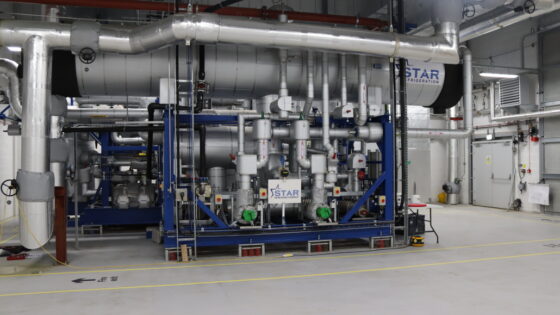A new low‑carbon heat network that draws energy from the Leeds and Liverpool Canal has begun operating in Liverpool, marking an early tangible step in the city region’s bid to reach net zero.
The Mersey Heat Energy Centre, installed at Princes Dock as part of the Liverpool Waters development, was unveiled this week by Peel Group and heat network specialist Ener‑Vate. The scheme uses water source heat pumps to extract warmth from the canal and boost it to temperatures suitable for heating buildings across a 6km distribution network.
The network currently supplies heat and hot water to residential and commercial buildings including Peel’s Liverpool Waters developments, Torus Development’s Hartley Locks and Harcourt Development’s Titanic Hotel and Stanley Tobacco Warehouse. The centre is reported to deliver about 20GWh of heat annually, sufficient for up to 6,700 homes and roughly 120,000m2 of commercial space. Planning consent exists to expand capacity to around 45GWh, which the developers say would serve the equivalent of 17,000 homes.
Project partners estimate the scheme will cut carbon emissions by about 4,200t a year. The Energy Centre incorporates one of the UK’s largest two‑stage water source heat pumps, supplied by Star Refrigeration and installed by Vital Energi. The project also received a £7.5M grant from the government’s Heat Networks Investment Project (HNIP) towards construction of the energy centre and network.
Liverpool City Region, which declared a climate emergency in 2019 and aims for carbon neutrality by 2035 or sooner, has already seen roughly a 40% reduction in emissions since 2005, city leaders pointed out at the launch.
Heat networks – systems that produce heat centrally and distribute it via insulated pipes to multiple buildings – are being promoted by local and national governments as a way to reduce reliance on individual gas boilers and cut emissions from heating, which accounts for a large share of UK carbon output. Using surface water bodies as a heat source is one of several approaches to district heating; others include waste heat recovery and energy from biomass or thermal stores.
Industry figures say surface water heat pumps can offer lower operational emissions than conventional gas heating, though their performance depends on factors such as pump efficiency, network losses, and the proportion of electricity sourced from low‑carbon generation. The Mersey Heat project’s developers cite the canal as a reliable heat source for the local context, and point to the grant funding as essential to getting the scheme operational.
If the planned expansion goes ahead, the network could play a larger role in decarbonising heating for new developments in the city’s docklands.
Liverpool City Region cabinet member for net zero and St Helens Council leader Anthony Burns said: “Building a cleaner, greener future isn’t just about meeting targets – it’s about improving people’s lives. The Mersey Heat Energy Centre is a fantastic example of how we can use our region’s strengths and ingenuity to cut carbon, lower energy bills, and support jobs in the industries of the future.
“I know the scale of the challenge we’re facing – but also the scale of the opportunity. Projects like this show that we’re serious about hitting our target to be net zero by 2035, at least a decade ahead of the rest of the country, and that the Liverpool City Region is leading the way.”
Liverpool City Region cabinet member for innovation and Liverpool City Council leader Liam Robinson said: “The launch of the Mersey Heat Energy Centre is a landmark moment in Liverpool’s journey towards a cleaner, greener future.
“It is a visible example of how Liverpool is leading the way on low carbon infrastructure, protecting historic buildings, cutting emissions and creating long term green value for our communities.
“Liverpool has long been a leader in climate action, and this project reinforces our commitment to achieving net zero. It’s not just about infrastructure, it’s about creating a legacy of sustainability that benefits our communities, our economy, and our environment.
“I’m proud to see this vision and investment come to life, creating jobs in the emerging green economy. I want to thank all the partners involved for helping Liverpool take another bold step towards a low carbon future.”
Peel Group investment director David Tatton said: “With the UK’s target to reach net zero by 2050, today is an important milestone for Liverpool’s journey to decarbonisation. Projects like this not only play a vital role in helping the country meet its carbon reduction goals, but it also demonstrates what can be achieved through innovation, collaboration and a commitment to a cleaner future.”
Ener-Vate strategy and development director Jo Longdon said: “The Ener-Vate team is thrilled to have been part of this exciting project from the very beginning and officially opening the new Mersey Heat Energy Centre today marks a huge milestone for us and for Liverpool. The city is leading by example, paving the way for decarbonisation and for other cities to follow suit in leaving fossil fuels behind and delivering low carbon sources of heat.”
Vital Energi regional director Andrew Wightman said: “We are pleased to see the new Mersey Heat Energy Centre now officially open, and proud to have played a pivotal role in the design, build, and maintenance of this network, which will be delivering low-carbon infrastructure for the city. It is a showcase project for Liverpool, and other areas across the UK looking to achieve their net zero aspirations.”
Like what you’ve read? To receive New Civil Engineer’s daily and weekly newsletters click here.
